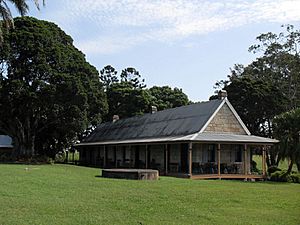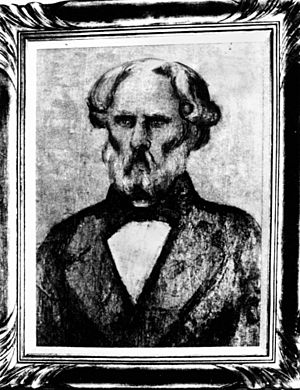Wolston House facts for kids
Quick facts for kids Wolston House |
|
|---|---|

Wolston House, from east, 2009
|
|
| Location | 223 Grindle Road, Wacol, City of Brisbane, Queensland, Australia |
| Design period | 1840s–1860s (mid-19th century) |
| Built | 1852–1860s |
| Official name: Wolston House | |
| Type | state heritage (built, archaeological) |
| Designated | 21 October 1992 |
| Reference no. | 600339 |
| Significant period | 1852–1860s (fabric) 1852–1960, 1965 (historical) |
| Significant components | trees/plantings, farmhouse, pump, wall/s, well, pathway/walkway, gate – entrance, cellar |
| Lua error in Module:Location_map at line 420: attempt to index field 'wikibase' (a nil value). | |
Wolston House is a special old house in Wacol, Australia. It's now a museum where you can learn about the past. This historic home was built between 1852 and the 1860s. It is listed on the Queensland Heritage Register, which means it's an important part of Queensland's history. Today, the National Trust of Queensland looks after it.
Contents
The Story of Wolston House
Wolston House started as part of a big farm called the Wolston Estate. Dr. Stephen Simpson first set up the property in 1852. Later, Matthew Goggs made it even bigger in the 1860s.
Dr. Stephen Simpson's Early Days
Dr. Stephen Simpson was an important person in early Queensland. He was a doctor and a Justice of the Peace. In 1842, he became the Commissioner for Crown Lands for the Moreton Bay area. This was when people first started settling there after it stopped being a prison colony.
Simpson first lived in a place called Woogaroo, near Goodna. In 1851, he bought about 640 acres (2.6 square kilometers) of land. This land was east of his first home and had great views of the Brisbane River.
Building the First Home
The new property was carefully planned in 1852. A surveyor named William Pettigrew helped lay it out. They included a house, garden, stables, and other buildings. Dr. Simpson loved plants and gardening. It's thought he might have planted the fig trees still at Wolston House.
The house Dr. Simpson lived in was quite small. He built a two-room brick cottage with a sandstone basement. It had a shingled roof and a separate kitchen. This small cottage is now the very heart of the larger Wolston House you see today.
A Sad Event and a New Owner
In 1856, a sad event happened. Dr. Simpson's nephew, John Ommaney, who was his heir, died after falling from his horse. This might have made Dr. Simpson decide to leave Australia. In 1860, he put the Wolston estate up for sale and went back to England. By then, the estate was very large. It had 2,000 acres (8.1 square kilometers) of fenced land. There were also big gardens, orchards, and many horses and cattle.
Matthew Buscall Goggs bought Wolston in October 1860. He continued to use the estate for raising cattle and horses. He made the property even bigger, owning about 100,000 acres (400 square kilometers) at one point. Matthew Goggs had a large family of ten children. To make space for them, he added a sandstone extension to the house in the 1860s. Later, in the 1870s, a cedar annex was added for the children's bedrooms.
Changes Over the Years
After Matthew Goggs passed away in 1882, his eldest son, also named Matthew Buscall, managed the estate. The family bought and sold parts of the land over time. By 1907, the Wolston property was smaller, with about 650 acres (2.6 square kilometers) around the house.
In 1907, the Grindle family bought Wolston House. They turned it into a successful dairy farm. They milked many cows and sold milk to Brisbane. The Grindles also made some changes to the house. They replaced the shingle roof with corrugated iron. They also made the verandah posts more evenly spaced.
In 1956, Robert Hurley bought the property. The house and land were not in good shape then. The Hurleys worked hard to improve the property. They started a successful dairy business.
Saving Wolston House
In 1960, the Queensland Department of Agriculture and Stock took over the property. They wanted to build a tick research center. They planned to knock down the old farm buildings and even the house. However, many groups, including the Queensland Women's Historical Association and the National Trust of Queensland, fought to save it.
Because of their efforts, Wolston House was saved! In 1965, the house was given to the National Trust. It became their very first historic property to look after. Important people like Sir Raphael Cilento and architect Karl Langer helped a lot in saving the house.
When the National Trust took over, the house needed a lot of work. They repaired and rebuilt parts of it. They decided to remove a timber section at the back. This part was added later and didn't fit their idea of how the house looked originally. Today, people who work to save old buildings try to change them as little as possible. Wolston House has been a museum for over 30 years. It helps us see how ideas about preserving history have changed.
What Wolston House Looks Like
Wolston House is in a peaceful, rural area. It's between Brisbane and Ipswich and looks out over the Brisbane River. The land around it still feels like a farm. The house has a lovely old garden with big trees, a well, and a pump.
The house is made of sandstone and brick. It has a galvanised iron roof and six rooms. There are two cellars downstairs, which are like a half-basement. You can get to them from the back of the house.
The rooms are lined up along a verandah with timber posts. You enter the rooms through French windows, not a main front door. Inside, there's a large double room that can be divided by folding cedar doors. There's also a bedroom, a dining room, and a kitchen. The kitchen is a bit lower than the other rooms. Many of the wooden parts, like doors and window frames, are original.
Behind the house, you can still see brick walls from the children's wing. This part was built in the 1860s but was taken down in the 1970s. Wolston House is a museum now. There's a modern caretaker's house nearby. There's also a modern toilet block and an old railway building used for storage. Some of the original gate posts and parts of a wall from the 1930s are still there.
The furniture and items inside the house are from the past. They help show what life was like back then. Some items are connected to the people who lived or worked at Wolston House.
Why Wolston House is Important
Wolston House was added to the Queensland Heritage Register in 1992. It's important for several reasons:
- It shows how Queensland's history developed. It tells the story of early settlement and farming. It's also linked to the start of the National Trust of Queensland. People like Sir Raphael Cilento and Karl Langer helped save it.
- It's a rare and special old building. Wolston House is one of the few early homesteads still standing. It was mostly built in the 1860s, but it includes the even older 1852 cottage. The way it was built shows old techniques that aren't common in small rural buildings from that time.
- It shows how early settlers lived. The design of the house, without a formal main entrance, gives us clues about the lifestyle of the first European settlers in the area.
- It's beautiful to look at. The house and its setting in the landscape are very appealing. Many people in the community enjoy its beauty.
- It's connected to important people. The oldest part of the house is linked to Dr. Stephen Simpson. He was a very important public figure in Brisbane's early years. The house is also connected to the National Trust of Queensland. Sir Raphael Cilento and Karl Langer played big roles in making it the Trust's first property.


